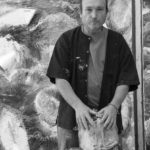Barceló, Miquel

(Felanitx, Mallorca, 1957) considered one of the most important contemporary artists of Spain. His work ranges from canvas and murals to ceramic and terracotta sculptures. His painting contains different cultural spaces, such as the mediterranean and, from his time living in Mali, the african landscape and way of life. Recently he has introduced in his artworks intellectual reflections of his own private environament, such as his studio or library. In addition, Barceló worked on book illustrations, including the ones from Dante, Paul Bowles and Enrique Juncosa.
His early interest in art comes from his mother, a traditional mallorcan landscape painter, while he experienced his first artistic epiphany when he traveled to Paris in 1974 and discovered the works of Paul Klee and Jean Dubuffet’s , as well as art brut, which influenced him deeply.
His participation in the Sâo Paulo Biennal (1981) and in the Documenta of Kassel VII (1982), projected Barceló onto an International artistic scene very early on. Due to this artistic achievents, he was awarded in 1986 the Premio Nacional de Artes Plásticas and in 2003 the Príncipe de Astúrias de las Artes prize.
Barceló has lived in Mali during different periods of his life, which greatly influenced his paintings. In 1992 he married in Artá and, some months later he became a father. The couple currently lives in their House-studio in Sa Devesa de Ferrutx (Mallorca).
In 2002 Barceló made a memorable illustration of Dante’s
La Divina Comedia, and in 2007 he opened an extraordinary ceramic altarpiece in the Most Holy Chapel of the Cathedral of Mallorca, which recreates the miracle of bread and fishes. That same year he attended drawing and modeling lessons at the School of Decorative Arts in Palma de Mallorca, and then entered the School of Fine Arts Sant Jordi, in Barcelona, although he was more preoccupied in teaching himself, than attending class. .
In November 2008 he presented the decoration of the dome of Room XX of the United Nations Palace in Geneve as hall of the Human Rights and the Alliance of the civilizations. In that hall, Barceló made thousands of marine stalactites, which toghether evoke a big universal sea.
The baroque painting, the art brut, the north american abstract expressionism, the italian povera art, the artworks by Miró and Antoni Tàpies, are the principal influencies that Barceló has transformed into a great personal synthesis of a neoexpressionist nature and overflowing imagination, with dense matèric presence and immense plastic wealth.